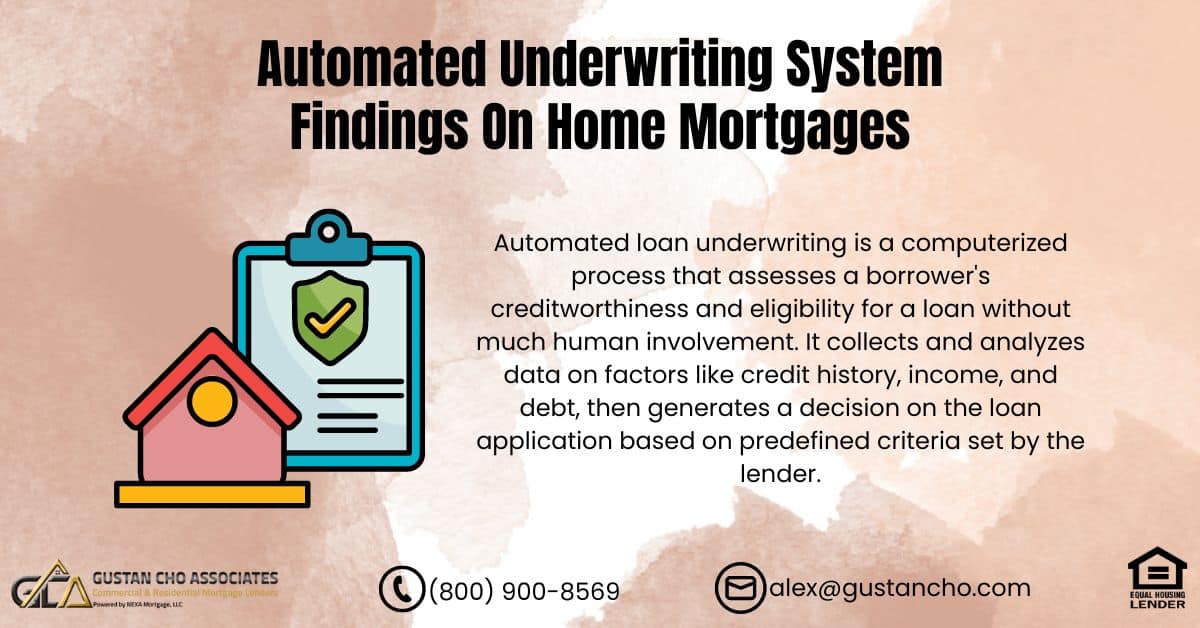In this blog, we will cover and discuss the automated underwriting system approval, which is also referred to as AUS findings. The automated underwriting system approval is what is needed for a mortgage borrower to go forward with the mortgage process. The automated underwriting system will render three types of findings:
- approve/eligible per AUS: A/E per AUS means the borrower has an automated approval and the borrower meets all agency mortgage lending guidelines so the file can proceed
- refer/eligible per AUS means the borrower may be eligible but the automated underwriting system needs to refer the file to a human underwriter for underwriting
- refer with caution per AUS means the borrower is not eligible and does not meet the agency mortgage guidelines
What is Automated Loan Underwriting Process?
Automated loan underwriting is a computerized process that assesses a borrower’s creditworthiness and eligibility for a loan without much human involvement. It collects and analyzes data on factors like credit history, income, and debt, then generates a decision on the loan application based on predefined criteria set by the lender.
This process offers speed, consistency, and efficiency but requires compliance with regulations and occasional human oversight.
What Is The Difference Between Fannie Mae DU and Freddie Mac LP?
Can I Get an AUS Approval on Freddie Mac’s LP and Not on Fannie Mae’s DU and Vice Versa?
There are times when you can get an approve/eligible per automated underwriting system (AUS) on Freddie Mac’s LP but not on Fannie Mae’s DU. There are other times when you can get an AUS approval on Fannie Mae’s DU but not on Freddie Mac’s LP. Experienced loan officers can play around with the AUS if they do not get an approve/eligible per AUS.
For example, they can see if they can make the down payment higher, add more reserves, or pay off debt so the debt to income ratios are lower. There are many creative ways of getting an approve/eligible per AUS if they do not get it the first time around. There are many instances where you may not get an automated approval with Fannie Mae’s DU AUS but may get an approve/eligible per AUS with Freddie Mac’s LP AUS.
Difference Between The Automated Underwriting System Approval Versus Manual Underwriting
Manual underwriting is when the automated underwriting system cannot render an approve/eligible but renders a refer/eligible. You can manually underwrite refer/eligible AUS findings. There are only two loan programs that allow manual underwriting. VA and FHA loans.
The automated underwriting system is for FHA, VA, USDA, and Conventional loans. Whenever loan officers enter data into the Automated Underwriting System, the loan type needs to be entered. The automated underwriting system will then follow the loan program’s agency guidelines in analysis before it renders an automated underwriting system approval or denial.
Manual Underwriting on Refer/Eligible per AUS Findings
There is not much difference between manual versus automated underwriting systems. Only FHA and VA loans allow manual underwriting. To be eligible for manual underwriting, borrowers need to have been timely on all of their monthly debt payments for the past 12 months. VA loan borrowers can get away with just timely payments for the past 12 months.
The next major difference between manual versus automated underwriting system approval is the cap on the front-end and back-end debt-to-income ratio requirements which we will further discuss in the next paragraph. Another difference between manual versus AUS approval is verification of rent.
Speak With Our Loan Officer for Mortgage Loans
Manual Underwriting Guidelines on Verification of Rent
Rental verification is required for manual underwriting on both FHA and VA loans. Verification of rent is only valid if you have been paying by check and/or online and it can be documented. Cash payment with cash-paid receipt by the landlord is worthless. Or if you are renting from a registered professional property management company, a rental verification letter by the property manager can be used for 12 months of canceled checks and/or bank statements.
Gustan Cho Associates can exempt verification of rent for borrowers who are living rent-free with family to save money for the down payment.
Try The Best Mortgage Calculator Powered By Gustan Cho Associates
What Are The Debt-To-Income Ratio Guidelines on Manual Underwriting
The main difference between manual underwriting versus AUS approval is the lower front-end and back-end debt-to-income ratio requirements. DTI caps on manual underwriting are based on the number of compensating factors borrowers have.
With no compensating factors, the max front-end debt-to-income ratio is 31% and the back-end is 43%. With one compensating factor, the cap on the debt-to-income ratio is 37% front-end and 47% back-end. With two compensating factors, the max front-end DTI is 40% and 50% back-end.
Mortgage underwriters have a lot of underwriter discretion on manual underwriting. Mortgage underwriters can exceed the above-recommended debt-to-income ratio manual underwriting recommended guidelines if the underwriter feels the borrower has strong compensating factors and strong residual income.
What Are The Manual Underwriting Guidelines on Recent Late Payments
Manual underwriting can be done with refer/eligible per AUS findings. However, the borrower needs to meet manual underwriting guidelines. Part of manual underwriting guidelines is the borrower needs timely payments in the past 24 months with no late payments. VA manual underwriting guidelines are more lenient than FHA manual underwriting guidelines on late payments.
You can get away with only 12 months of on-time payments versus 24 months of on-time payments on VA loans.
FHA and VA Manual Underwriting Guidelines on Refer/Eligible Per AUS
There are times when the automated underwriting system cannot render an automated underwriting system approval but will render a refer/eligible per automated underwriting system findings. Refer/eligible per AUS findings can be manually underwritten. However, only FHA and VA loans allow manual underwriting.
FHA and/or VA manual underwriting guidelines apply.
Automated Underwriting System For FHA and VA Loans
The manual underwriting guidelines on FHA and VA loans are almost identical with regards to front-end and back-end debt-to-income ratios, compensating factors, the waiting period requirements, and verification of rent requirements. Manual underwriting requires verification of rent.
At Gustan Cho Associates, verification of rent is waived for borrowers who have been living rent-free with family in order to save money for the down payment and closing costs on manual underwrites. Living rent-free with a family member form provided by Gustan Cho Associates will need to be completed, signed, and dated.
How Accurate is Automated Underwriting?
The automated underwriting system is generally accurate, relying on algorithms and statistical models to assess borrower creditworthiness based on various factors. It can swiftly process large quantities of data and consistently apply predefined criteria, leading to reliable decisions.
While automated underwriting can provide fast and consistent results, it’s essential to periodically evaluate and refine these systems to ensure they remain effective and compliant with regulations.
Their accuracy ultimately depends on the data input quality and the algorithms’ sophistication. Additionally, human oversight is often necessary to address exceptional cases or unexpected situations that automated systems may not handle effectively.
What is the Benefit of Automated Underwriting?
Automated underwriting offers significant benefits such as efficiency, consistency, and cost-effectiveness. Streamlining the loan application process and consistently applying predefined criteria reduces processing time and minimizes the potential for human error or bias.
This leads to lower operational costs for lenders and improved customer experiences for borrowers. Additionally, automated systems can handle large volumes of applications efficiently, aiding scalability and providing sophisticated risk management tools to help lenders make informed decisions and mitigate loan defaults.
Manual Underwriting Bad Credit Mortgage Guidelines
You can have prior bad credit, outstanding collections, and/or charged-off accounts but the AUS and lenders want to see rebuilt and re-established credit. Timey payments after bankruptcy, foreclosure, deed in lieu of foreclosure, short sale, late payments, collections, charge-offs, and other derogatory credit is what lenders want to see. Rebuilt and reestablished credit after prior bad credit with no late payments is the best assurance in getting an approve/eligible per automated underwriting system. Speak With Our Loan Officer for Mortgage Loan with Bad Credit
Manual Underwriting Guidelines on Timely Payments In The Past 24 Months
The key with manual underwriting is borrowers need timely payments in the past 24 months. One or two late payments are not always deal killers with a good letter of explanation with supporting documentation and extenuating circumstances. Not all lenders will manually underwrite FHA and/or VA loans.
Many lenders consider manual underwriting too risky so they have lender overlays on manual underwrites where they do not accept them. However, a large percentage of our files at Gustan Cho Associates are FHA and/or VA manual underwrites. Mortgage underwriters have a lot of discretion on manual underwriting files.
How The Automated Underwriting System Approval Process Works
The automated underwriting system approval is what is needed to proceed with the mortgage approval process. One of the major changes that have developed in recent years in the mortgage industry and since the 2008 Housing Crisis is the use of technology and the advancement of the automated underwriting system (AUS).
The automated underwriting system is the use and utilization of computers to underwrite mortgage loans. The automated underwriting system approval, also known as AUS, has made mortgage approvals automated.
How Long Does The Automated Underwriting System Approval Process take?
The automated underwriting system is very quick, accurate, and easy to use where within minutes, the loan officer will get the automated findings of the AUS. Within minutes the AUS can render automated findings approvals.
The automated underwriting system can render an AUS approval literally in less than couple of minutes.
Before the loan officer can use the automated underwriting system, the loan officer needs to complete the mortgage applicant’s loan application, complete the mortgage disclosures, run a tri-merger credit report, and review the borrowers income docs. The mortgage loan application requires a lot of information including income, assets, liabilities, employment history, and other information for the automated underwriting system. Once all the data is collected, it is entered in the automated underwriting system for the AUS Findings.
Who Uses The Automated Underwriting System?
As mentioned in other sections of this guide, the automated underwriting system is a sophisticated computerized highly technologically advanced mortgage system used by mortgage brokers, mortgage bankers, correspondent lenders, banks, credit unions, and all financial institutions who originate, process, underwriter, and/or services mortgage loans.
How Accurate is Automated Underwriting?
The AUS system has a 97% plus accuracy. If the AUS cannot determine the findings, it will render a refer/eligible per AUS which means the file is eligible for manual underwriting. When a loan officer enters the data of the borrower, the loan officer also populates the borrower’s tri-merger credit report.
The algorithm of either FHA, VA, USDA, Fannie Mae, Freddie Mac are already coded and programed in the AUS. The AUS will analyze the mortgage applicant’s loan application, credit report, and all the information on the report including public records, income, assets, liabilities, and other factors, and render automated findings within couple of minutes.
The automated underwriting system is a sophisticated advanced automated system that has been programed with the guidelines of government and/or conventional loans. Click here to apply for mortgage loans
How Does The Underwriting Process Work?
The mortgage underwriting process is the process of evaluating mortgage loan applicants’ creditworthiness and their ability to repay a mortgage loan by analyzing the applicant’s income, debts, and credit history. A mortgage underwriter is assigned to every borrower.
The assigned mortgage underwriter who underwrites the file is responsible for issuing the conditional loan approval, clearing conditions, and issuing the clear to close. The mortgage underwriter can also deny the file if the borrower does not qualify or does not meet the mortgage guidelines. Click here to pre-qualify for mortgage loans today
How do the Automated Underwriting Systems Work?
Prior to the invention of the automated underwriting systems, loan officers manually approved initial mortgage pre-approvals. It took some time in order to render a mortgage approval. Once the automated underwriting system was created and launched, mortgage approval can be issued in a matter of minutes after a mortgage loan originator inputs all pertinent data into the AUS and get an automated underwriting system approval.
The automated underwriting system only picks up whatever is entered. For example, the AUS will read the listed credit tradelines, derogatory items, late payments, collections, charged-off accounts, and public records on the credit report. The AUS does not pick up items that are not reporting on credit reports such as public records and/or judgments that do not report on credit reports. If this is the case, the automated findings are null and void.
What Does the Automated Underwriting System Check for?
How Is The Credit Report Analyzed By The Automated Underwriting System?
The automated underwriting system can’t read credit items that are not on the credit report. The automated underwriting system can’t read a disputed credit tradeline. The automated underwriting system will only be able to use and analyze data that reports on credit reports.
The data from the tri-merger credit report will be thoroughly analyzed including payment history, credit scores, derogatory credit tradelines, public records, and payment patterns.
Public records will get snagged by mortgage underwriters during a third-party national public records search all lenders do during the mortgage process. This is why it is very crucial and important for loan officers to go over the line items of their credit reports one by one and ask about the validity of their credit reports.
Is Automated Underwriting Better Than Manual?
Why do lenders use the automated underwriting system and is automated underwriting better than manual? There is a reason why all current lenders use automated underwriting system than processing mortgages from A through Z by hand like the old days. Hands down, the automated underwriting system is much faster and more cost-efficient than manual underwriting.
Automated Underwriting System Fannie Mae
Automated Underwriting System Freddie Mac
Freddie Mac’s version of their automated underwriting system is known as the LP, the Loan Prospector. These two systems are equivalent to a highly sophisticated brain. Both DU and LP AUS have the ability to determine and analyze each mortgage applicant’s risk factor.
Evaluation of risk assessment by AUS is done by evaluating the inputted data and the applicant’s credit scores and credit history. The automated underwriting system approval determines whether an applicant is approved or not by issuing an AUS Findings Report. The report states whether the applicant is approved eligible or not.
What Happens After Automated Underwriting?
If approved eligible, the Findings Report will indicate what documents are required to verify the application data. If the borrower does not get an approve/eligible per AUS, the loan officer can try different methods such as inputting larger down payments, adding reserves, paying down credit cards, or paying off outstanding collections to see if running other scenarios would render an approve/eligible.
Another important note is if you do not get an approve/eligible with Fannie Mae’s DU AUS, try Freddie Mac’s LP AUS. There are many instances where Freddie Mac LP AUS may be more forgiving than Fannie Mae’s DU AUS and vice versa. For example, Fannie Mae DU AUS may not like late payments after bankruptcy but you may get an approve/eligible per Freddie Mac’s AUS.
Importance Of Automated Underwriting System Approval
Almost all mortgage lenders will go by the Findings report of the AUS initially. Lenders with no lender overlays will just go off the AUS Findings Report. However, if mortgage lenders have lender overlays, they will initially go off the AUS Findings. They will do a manual overview to see if the borrower meets their particular mortgage lender overlays.
Why Do Lenders Downgrade Automated Underwriting System Approvals To Manual Underwriting?
If it is not approved by the automated underwriting system, the chances are that it needs to be downgraded to a manual underwrite only if the AUS Findings render a refer/eligible per AUS finding. Not all mortgage lenders will do manual underwriting.
Gustan Cho Associates is one of the very few national mortgage companies licensed in multiple states with no lender overlays on government and conventional loans. Gustan Cho Associates just go off the AUS FINDINGS and has zero lender overlays. A large percentage of our mortgage loan applications are FHA and/or VA manual underwrites.
Pre-Approved Through Automated Underwriting
All Findings, whether done at one lender or another, will render the same result. Most mortgage lenders will halt the mortgage process and will not submit a file that is not AUS approved.
Not all mortgage companies do manually underwrite a mortgage loan. Only FHA and VA loans allow manual underwriting.
Many mortgage lenders will not manually underwrite mortgage loans due to the added layered risk factor as part of their lender overlays. All automated underwriting system-approved files are assigned to a human mortgage underwriter. The loan officer will make sure that all documentation, credit, income, assets, and liabilities are correct before it is submitted to AUS. Proper documentation will be required to verify all data that was inputted into the computer to get the AUS approval.
Applying With The Best Mortgage Lenders For Manual Underwriting
Mortgage loan applicants with an approve/eligible per automated underwriting system approval that can provide all conditions from the AUS will not have any issues getting a clear to close. Proper documentation will be required. The great news with Gustan Cho Associates is we are a national mortgage company with no lender overlays on government and/or conventional loans. Gustan Cho Associates only goes by Automated Underwriting System Findings and has zero overlays. Click here for apply with the best mortgage lender for Mortgage Loans
Therefore, as long as the borrower gets an approve/eligible per AUS and can satisfy the conditions of the AUS, the borrower will close on their home loan. Mortgage Borrowers who are looking to get qualified with a lender with no lender overlays, please contact us at Gustan Cho Associates at 1-800-900-8569 or text us for a faster response. Or email us at gcho@gustancho.com. The team at Gustan Cho Associates is available 7 days a week, on evenings, weekends, and holidays.
FAQ: Automated Underwriting System Findings On Home Mortgages
1. What is the automated underwriting system approval? The automated underwriting system approval, or AUS findings, is a crucial step in the mortgage process. It indicates whether a borrower is approved for a mortgage based on predefined criteria set by the lender.
2. What are the types of AUS findings? There are three types of AUS findings:
- Approve/Eligible per AUS: The borrower meets all agency mortgage lending guidelines and can proceed with the mortgage process.
- Refer/Eligible per AUS: The borrower may be eligible, but the file needs to be referred to a human underwriter for further review.
- Refer with caution per AUS: The borrower does not meet agency mortgage guidelines and is not eligible for approval.
3. How does automated loan underwriting work? Loan underwriting through automation is a process that evaluates a borrower’s creditworthiness and loan eligibility by analyzing details such as credit history, income, and debt. It generates a decision on the loan application quickly and efficiently but still requires compliance with regulations and occasional human oversight.
4. Is automated underwriting better than manual underwriting? Yes, automated underwriting is generally faster and more cost-efficient than manual underwriting. It relies on sophisticated algorithms and statistical models to assess borrower creditworthiness accurately and consistently.
5. How accurate is automated underwriting? Automated underwriting systems are highly accurate, with a 97% plus accuracy rate. They rely on predefined criteria and data analysis techniques to make reliable decisions on loan applications.
6. What are the benefits of automated underwriting? Automated underwriting offers efficiency, consistency, cost-effectiveness, and scalability benefits. It streamlines the loan application process, reduces processing time, and provides sophisticated risk management tools for lenders.
7. Who uses the automated underwriting system? Automated underwriting systems are used by mortgage brokers, bankers, correspondent lenders, banks, credit unions, and other financial institutions to originate, process, underwrite, and service mortgage loans.
8. What happens after automated underwriting? If the borrower receives an approved/eligible per AUS, they will proceed with satisfying the conditions outlined in the AUS findings. If not, the loan officer may explore alternative scenarios or consider manual underwriting options.
9. Can automated underwriting approvals be downgraded to manual underwriting? If the AUS findings render a refer/eligible per AUS, the file may need to be downgraded to manual underwriting. However, not all lenders offer manual underwriting, which may involve additional risk factors.
10. How do I apply with the best mortgage lenders for manual underwriting? Gustan Cho Associates is a national mortgage company that offers loans without lender overlays for borrowers seeking government and conventional loans. Borrowers must meet AUS criteria and provide proper documentation to proceed with their mortgage application.
This blog about Automated Underwriting System Findings On Home Mortgages was updated on March 18, 2024.
Speak With Our expert for Mortgage Loans, Click Here









